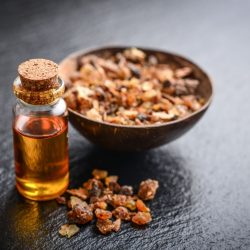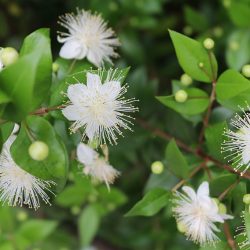Radiant Eucalyptus, scientifically known as Eucalyptus radiata, is a tree remarkable not only for its majestic stature in the Australian landscape, but also for its many applications in natural medicine and aromatherapy. Belonging to the Myrtaceaefamily, this tree has captured the attention of researchers and natural health practitioners for its properties exceptional properties particularly its essential oil. In this article, we’ll explore in depth the botanical characteristics, natural habitats and, above all, the many ways in which Eucalyptus Radié essential oil can be used. From its therapeutic benefits to its applications in personal care and aromatherapy, Eucalyptus Radié offers an impressive range of virtues, earning it a place of choice in the world of natural remedies. Our journey to the heart of this essence will lead us to discover its biochemical components, its mode of action and the precautions for use, providing a complete and nuanced overview of this fascinating tree and its essential oil.
What are the characteristics of Eucalyptus Radié?
Eucalyptus Radié, whose botanical name is Eucalyptus radiata, belongs to the Myrtaceae family.
What are its botanical attributes?
The Radiant Eucalyptus (Eucalyptus radiata) is an Australian tree capable of reaching a height of 50 metres, although the average is around 30 metres. It thrives on the plateaux of New South Wales and in the coastal areas of Victoria in Australia. This tree has grey or grey-brown fibrous bark that peels off in long strips, as well as small green branches.
The leaves are green and concoloured, narrow and lanceolate, 7 to 15 cm long and 0.7 to 1.5 cm wide. They give off a peppery mint scent when kneaded, leading to their classification as “peppermint” eucalyptus. The creamy yellow flowers appear in summer, between October and January, and are grouped in clusters of 11 to 20.
Where does it grow?
This is one of the species of eucalyptus most widely used in pharmacy for the properties of its essential oils. Eucalyptus radiata is a shrub of variable size, much smaller than its relative, Eucalyptus globulus, which can grow to 50 metres. Originally from Australia, it is also found in South Africa. The leaves become narrow and lanceolate when mature, although they are more rounded when young.
Eucalyptus radiata has been recognised for its medicinal properties since the early 20th century. Although native to Australia and South Africa, it has adapted well in Mediterranean areas, as well as in North and South America. It favours drained soils in subtropical regions, including south-east Australia, New South Wales and the coastal regions of Victoria. In these areas, Eucalyptus radiata thrives on perfectly drained soils.
What are the uses of Radiant Eucalyptus essential oil?
The main distillation ofEucalyptus Radiata essential oil, known by its Latin name Eucalyptus radiata A.Cunn. ex DC., comes from the plant’s leaves and is renowned for its therapeutic potential in the treatment of respiratory ailments. It is an ideal ally for soothing various winter ailments and boosting the immune system during epidemic seasons.
Research has shown that Eucalyptus essential oil extract can stimulate the innate cellular immune response. This discovery provides scientific support for further use of this plant extract, in addition to its antiseptic and anti-inflammatory properties, and encourages further research using the individual components of this essential oil. (4)
What is its composition?
The biochemical components of the essential oil in question fall into different chemical categories, as follows:
- Monoterpenes (approximately 8%): Alpha-pinene, Beta-pinene, Limonene, Myrcene, Sabinene
- Monoterpenols (approximately 20%): Alpha-terpineol, Terpinene-4-ol, Borneol, Geraniol
- Terpene esters (approximately 3%): Alpha-terpenyl acetate
- Terpene oxides (between 62 and 74%): 1,8-cineole
This information is invaluable in understanding the chemical make-up of essential oils, and can help predict or explain their properties and potential therapeutic or industrial uses. In fact, one study analysed the chemical composition of Eucalyptus Radiata essential oil, revealing that the main components are 1,8-cineole, α-terpineol and limonene. These discoveries are crucial to understanding the effectiveness of the essential oil in various therapeutic applications. (2)
What is its mode of action?
Eucalyptol or 1,8-cineole, responsible for stimulating the exocrine glands of the respiratory mucosa, facilitates the liquefaction of secretions and the activation of bronchial epithelial cilia, leading to optimised expulsion of respiratory congestion. The drying properties of alpha-pinene and 1,8-cineole also act to minimise mucus. In fact, a comprehensive systematic review of Eucalyptus has highlighted the molecular mechanisms of the biological actions of Eucalyptus species, focusing on 1,8-cineole as the main constituent responsible for Eucalyptus’ medicinal attributes (1).
Studies highlight the bronchodilator efficacy of eucalyptol, attributed to its ability to relax the smooth muscles of the airways, potentially inhibiting calcium influx across the cell membrane, thereby relieving coughs.
The combination of alpha-terpineol and eucalyptol has antiviral properties, inhibiting intracellular virus replication and showing significant action against various viruses such as the infectious bronchitis virus (IBV). The essential oil in question is ideal for winter use, stimulating immunity by increasing the phagocytic activity of immune cells such as monocytes and macrophages, thanks to terpinen-4-ol.
Its respiratory antiseptic action is particularly effective against bacterial infections, with notable activity against microbial strains such as Staphylococcus aureus and Escherichia coli. The oil is also active against certain fungal strains such as Aspergillus tubingensis, offering prospects for alternative phytosanitary applications.
Eucalyptus Radiata is also credited with inhibiting the production of pro-inflammatory molecules and mucus hypersecretion. It affects agents such as leukotriene B4 or interleukin 1-β. Eucalyptol acts as an analgesic by interfering with pain and cold signals via activation of TRPM8 receptors and inhibition of TRPA1 receptors.
Secondary properties such as antioxidant, parasiticide, skin absorption promoter, pediculicide and positivist complete the therapeutic profile of this essential oil.
What are the indications for eucalyptus?
Eucalyptus Radié essential oil has properties recognised by the scientific community, such as :
- Air antiseptic remarkable for its ability to purify the air and minimise airborne pathogens.
- Expectorant and mucolytic: Facilitates the expulsion of secretions from the respiratory tract and helps to thin mucus.
- Decongestant for the respiratory tra ct: Helps to lighten and clear obstructed airways.
- Immune stimulant : Encourages and revitalises the body’s natural defences.
- Paediatric: Recognised as suitable and beneficial in the paediatric context.
- Antibacterial support : Provides support in the fight against bacterial infections.
- Antiviral: Plays a role in preventing and fighting viral infections.
- Anti-inflammatory: Helps to moderate inflammatory responses.
- Insect repellent: Used as a repellent against various insects.
Recent studies have demonstrated a strong molecular interaction between the bioactive compounds present in Eucalyptus essential oil (mainly 1,8-cineole and eucalyptol) and the SARS-CoV-2 protease M pro enzyme, which plays a fundamental role in viral replication and transcription. These results suggest that Eucalyptus essential oil may have significant antiviral properties. (3)
Other traditional indications are attributed to it:
- Respiratory and ENT infections: Effective in preventing and treating conditions such as bronchitis, hacking coughs and sinusitis.
- Asthenia, immune deficiencies asthenia, immune deficiencies: Used in cases of fatigue and weakness of the immune system.
- Viral infections: Used to help prevent viral infections.
- Insect repellent: Traditionally used to repel insects.
The cosmetics industry also uses eucalyptus radiata to :
- Combination and oily skin : Acts as a purifying agent, particularly on acne-prone skin.
- Hair care: Helps revive dull hair and combat dandruff and itchy scalp.
Eucalyptus radiata also has energetic indications:
- Energising: Provides renewed energy and vitality.
- Relaxing: Helps to calm the body and mind.
- Intellectual stimulant: Promotes memory and intellectual stimulation.
- Inner calming: Helps to calm inner turmoil and persistent thoughts.
- Reduces stress and mental fatigue: plays a role in reducing stress and mental weariness.
How to use this essential oil?
Eucalyptus Radié essential oil should be used with caution. What’s more, as its indications are varied, there are many different ways of using it and dosages.
What dosage should I choose?
For a structured and logical approach to the use of Eucalyptus radiata essential oil in various therapeutic contexts, consider the following recommendations.
Local applications are recommended in cases of :
- Respiratory and ENT conditions (such as colds, rhinitis, otitis, coughs, pharyngitis, bronchitis): Apply to infected and sensitive areas, either undiluted or slightly diluted in a vegetable oil.
- Econtagious viral epidemics apply undiluted or slightly diluted to the chest, back or soles of the feet.
- Otitis: Apply pure or slightly diluted around the ear, three times a day for 8 to 10 days. Note that dilution is recommended for children aged 3 and over.
Oral use is recommended for ENT conditions. Take 2 drops of Eucalyptus radiata essential oil, diluted in vegetable oil, three times a day. This can be combined with the cutaneous route for greater effectiveness.
Olfactotherapy is recommended for :
- Inflammation of the nasal mucous membranes (such as rhinitis and sinusitis): Diffuse several times a day for one week.
- Emotional states (such as anxiety, nervousness, fixation or recurring thoughts): Use olfactotherapy methods to alleviate negative emotional states and promote mental calm.
- Fatigue and lack of concentration (including shyness and physical and mental fatigue): Use by olfaction, diffusion, inhalation or diluted in the bath via a solubol, to stimulate concentration and alleviate fatigue.
It’s important to remember that essential oils must be used with caution and in accordance with the precautions for use, particularly when applied orally and to the skin.
What are the precautions for use?
Eucalyptus Radié essential oil stands out for its flexibility of use and general tolerance, compared with other Eucalyptus essential oils. Its use is nevertheless subject to specific precautions:
- Avoid use by asthmatics and epileptics without prior medical advice.
- Forbidden for pregnant women under 3 months and infants under 3 months.
- Recommended dilution: 20% maximum in a vegetable oil when applied to the skin over a large area.
- Avoid applying to children’s faces and torsos, preferring the upper back and soles of the feet.
- Ingestion is not recommended for children under 12.
- May be diffused in the air, but dilute 30% with other essential oils to avoid drying out the respiratory mucous membranes. Use with caution with young children.
Although very well tolerated, this essential oil is subject to a number of contraindications:
- Not recommended for children under 2 years of age.
- Do not apply to the chest, neck or face of children under the age of 4.
- Oral use is not recommended for children under 12.
- Not recommended for people with gastrointestinal or biliary inflammatory disorders.
No drug interactions have been observed. However, caution should be exercised when taking drugs with a narrow therapeutic range. Consultation with a healthcare professional is recommended in case of uncertainty.
What is the story behind Eucalyptus Radiata?
Eucalyptus Radiata is a very large tree, generally reaching 50 metres in height, originally from Australia, where it was discovered in the 18th century. Eucalyptus has long been used in Aboriginal medicine to treat a variety of ailments. When cut, it exudes a red resinous gum, giving it the nickname of “Gum Tree”. There are many different species of Eucalyptus. Eucalyptus is unique in that it has properties that help combat respiratory ailments.
What are the origins of this plant?
Eucalyptus, and in particularEucalyptus radiata, plays a major role in traditional Australian pharmacopoeia, particularly among Aboriginal communities. The Aborigines, renowned for their ingenious use of plant resources, exploited the different parts of the eucalyptus plant in various ways in their medicinal and everyday practices:
- Making a poultice from crushed seeds, mixed with water, applied to the forehead to combat fevers.
- The use of leaves, not only as a natural dressing on wounds to promote healing, but also burnt to sterilise the air in the rooms where the sick lived.
- The use of pieces of wood placed in water containers to disinfect them.
The name “Eucalyptus” comes from the Greek, with “Eu”, meaning “good”, and “Kalypto”, meaning “to cover”, alluding to the flowers that remain partially confined even after they have bloomed. The ‘radiata’ species is also widely recognised and used in pharmacopoeia thanks to the medicinal properties of its essential oil.
In fact, the use of eucalyptus has not been limited to its medicinal benefits. The tree was also used for its drying properties, particularly in marshy areas. In this way, it helped to eradicate tropical diseases such as malaria. This earned it the nickname “fever tree”. Of the 800 or so species in the Eucalyptus genus, only around 15 are used in aromatherapy. Each of them is appreciated for its specific properties.
What is the history of Eucalyptus Radié in Europe?
The French naturalist Julien Houtou de la Billardière identified Eucalyptus Radié in 1792. France welcomed it in 1804. However,England had known about and imported its essential oil since the early 18th century. In particular, they imported Sydney Mint for its distinctive minty scent when the leaves are crumpled. From 1860, England began producing eucalyptus essential oil. It was used to disinfect surgical instruments.
The introduction of eucalyptus to the West in the 19th century was mainly aimed at pulp production in Mediterranean regions. Research into its medicinal properties, particularly its antiseptic and bronchodilator properties, began in the first half of the 20th century.
Native to Oceania, more specifically Australia and New Guinea, eucalyptus radiata belongs to a genus with a multitude of varieties. Europe imported eucalyptus in the 19th century, favouring its cultivation in the Mediterranean basin for its ability to dry out marshy areas. For centuries, the Aborigines had been discovering its beneficial properties, using the leaves for a variety of well-being purposes. Today, Eucalyptus radiata essential oil, inheriting these ancestral uses, is renowned for supporting superior respiratory comfort.
Test your knowledge of Eucalyptus Radié
You’ve discovered a lot of fascinating information about Radiant Eucalyptus in our article. But how much have you learned? Here’s a short interactive quiz to test your knowledge of this extraordinary plant. Whether you’re an aromatherapy expert, a natural medicine enthusiast or just curious to learn more, this quiz is a fun and informative way to check what you’ve learned. Answer the questions below and feel free to share your results and impressions in the comments section. Let’s go on a fun journey to the heart of Radiant Eucalyptus!
- What is the main characteristic of Radiant Eucalyptus essential oil that contributes to its medicinal properties?
- A. Limonene
- B. 1,8-Cineole
- C. α-Terpineol
- In which regions of the world is Eucalyptus Radié mainly grown?
- A. Europe and Asia
- B. Australia and South Africa
- C. North and South America
- What is one of the main uses of Eucalyptus Radié in aromatherapy?
- A. Muscle relaxation
- B. Improves concentration
- C. Stimulates hair growth
- According to recent studies, what property has the essential oil of Eucalyptus Radié demonstrated with regard to SARS-CoV-2?
- A. Ability to boost immunity
- B. Interaction with the protease M pro enzyme of the virus
- C. Reduces the duration of symptoms
- Why is it important to dilute Eucalyptus Radié essential oil before applying it to the skin?
- A. To improve absorption
- B. To reduce the risk of skin irritation
- C. To increase its effectiveness
We invite our readers to answer these questions in the comments below and to share their own experiences or additional knowledge about Eucalyptus Radié. Your contributions will enrich our community and help deepen our collective understanding of this fascinating plant.
References:
- (1) https://www.sciencedirect.com/science/article/pii/
- (2) https://www.tandfonline.com/doi/full/
- (3) https://www.ncbi.nlm.nih.gov/pmc/articles/PMC8706319/
- (4) https://www.ncbi.nlm.nih.gov/pmc/articles/PMC2374764/







